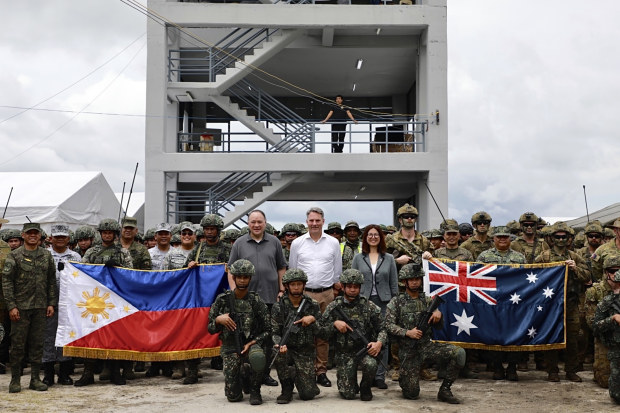Opinion

Australia cannot stay silent on China’s bullying of the Philippines
The latest maritime incident in the South China Sea warrants an unequivocal statement on escalating aggression and following through on promised joint patrols.
Jennifer ParkerNaval expertAs Prime Minister Anthony Albanese holds talks with US President Joe Biden, it’s time for Australia to lead in the Indo-Pacific with an unequivocal statement on China’s aggression in the West Philippine Sea, and a promise of joint patrols with the Philippines.
Albanese’s visit to Washington follows the cancellation of the Quad leaders meeting due to US internal instability. While the prime minister’s communications team may lament the missed opportunity for a snap of the leaders in front of the Sydney Opera House, there are many more effective ways to demonstrate regional leadership. Albanese’s visit to the White House is one such opportunity with the US under pressure abroad and its allies and partners engaged in conflicts in Europe and the Middle East.

Defence Minister Richard Marles with Philippine National Defence Secretary Gilberto Teodoro jnr (centre left) , Australian ambassador to the Philippines Hae Kyong Yu, and soldiers during military drills in the Philippines in August. AP
All this comes as questions are being raised in the US about the viability of the AUKUS submarine deal, which Mr Albanese must be hoping to quell. It is within this context that America’s ally, the Philippines, has again come under pressure through China’s increasingly aggressive tactics within its exclusive economic zone (EEZ). And Australia should be unequivocal in its statement that China’s aggressive actions are unacceptable. With Australia’s US ally stretched from Europe to the Middle East, it’s time for Australia to step up and lead in its own backyard.
Like clockwork, on Sunday the Chinese Coast Guard again attempted to blockade a resupply vessel en route to the deteriorating Philippine Navy vessel, BRP Sierra Madre, that is beached on Second Thomas Shoal. The dangerous manoeuvring of a Chinese Coast Guard vessel, increasingly a staple of maritime operations in the South China Sea, resulted in a collision with the contracted resupply vessel. During the same mission, a Chinese maritime militia vessel rammed a Philippines Coast Guard patrol vessel. While thankfully there do not appear to be any injuries, this increasingly dangerous cat-and-mouse game on the high seas is undermining the UN Convention on the Law of the Sea and the Convention on the International Regulations for Preventing Collisions at Sea. Both are central to Australia’s own maritime security.
China’s aggressive actions within the Philippine EEZ are not new, but the escalating nature of the aggression should be a cause for concern for Australia. In February, a Chinese Coast Guard ship reportedly shone a military grade laser a number of times into the bridge of a Philippine resupply vessel. In August, the Sierra Madre resupply mission again featured in global news with images of a Chinese vessel water cannoning the small Philippine vessel.
Guardrails start with being clear on where you stand and Australia must clearly state its view about what is happening in our own backyard.
While there are many disputed maritime claims across the region, what sets incidents in areas like Second Thomas Shoal apart is the feature’s undeniable standing in international law. The shoal sits 105 nautical miles west of the Philippines island of Palawan and more than 500 nautical miles from China. It is one of the features subject to the 2016 permanent court of arbitration tribunal ruling which found it to be a low tide elevation within the Philippines EEZ which China had no legal territorial claim to.
Following the August incident, subsequent visits to the Philippines from Defence Minister Richard Marles in August and Mr Albanese in September signalled a strengthening of ties between the two countries through the signing of a strategic partnership and announcement that joint maritime patrols would take place.
The strong messaging from the August and September visits is in danger of being undermined. The promised joint patrols appear yet to manifest, or at least they have not been publicly signalled, and the Australian Government has avoided making clear unequivocal statements about China’s bullying of the Philippines within its own exclusive economic zone.
As Mr Albanese visits the US signalling the strength of the relationship and hoping to move the needle on the fledging AUKUS arrangement, Australia should be clear and unequivocal that China’s actions towards the Philippines near Second Thomas Shoal are unacceptable. It can achieve this by following through with its planned joint patrols with the Philippines and making a clear statement on the weekend’s events.
In June, Mr Albanese spoke passionately at the Shangri-La dialogue in Singapore about the need for guardrails. Well, guardrails start with being clear on where you stand and Australia must clearly state its view about what is happening in our own backyard.
In a time of global crisis from the Middle East to Europe, it’s time for Australia as a regional power in the Indo-Pacific to take the lead and be unequivocal about China’s bullying of the Philippines.
Introducing your Newsfeed
Follow the topics, people and companies that matter to you.
Find out moreRead More
Latest In Foreign affairs & security
Fetching latest articles